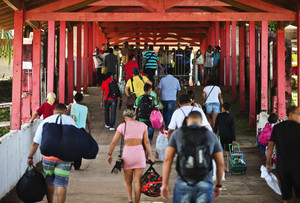
Thiago Gomes/Ag. Pará
Travelers at a port on Marajó Island: eating habits from industrialized regions of Brazil are spreading through the NorthThiago Gomes/Ag. ParáThe eating habits of Brazilians in the country’s industrialized regions are spreading into the interior of the Amazon and bringing their public health consequences in tow. In four towns on Marajó Island, a rural region on the northern coast of Pará, one out of three residents displays metabolic changes that increase the risk of cardiovascular disease and early death. From 2012 to 2013, researchers Sérgio França, Sandra Lima, and José Ricardo Vieira, all of the Federal University of Pará (UFPA), recorded the heights and weights of 787 adults from these towns and performed blood tests on them. Surpassing the national average of 29%, 34.1% of study participants developed metabolic syndrome, defined by the presence of three of these five clinical signs: high blood pressure; high fasting blood sugar; a waist circumference greater than 80 centimeters (cm) for women and 90 cm for men; low HDL cholesterol; and high triglycerides. The syndrome, which is associated with the overconsumption of processed food, appeared earlier in the women. In the 40-49 age group, 46% of women displayed the changes, while men only presented higher rates (43%) as of the 50-59 age bracket (PLOS ONE, December 9, 2016).
Republish